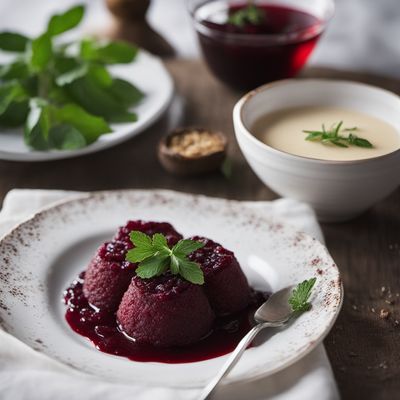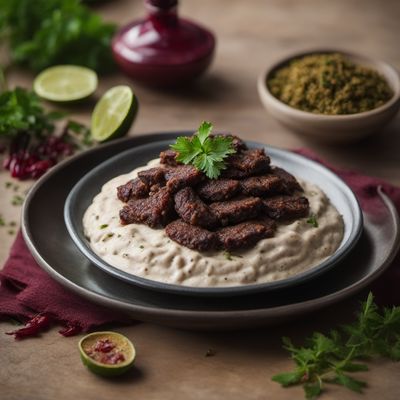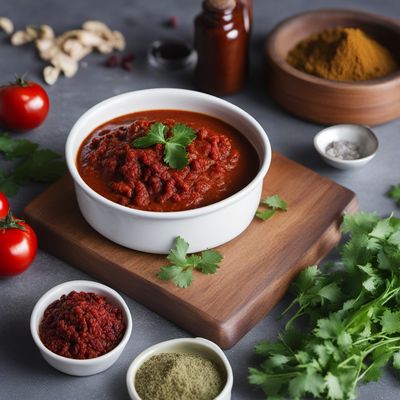
Ingredient
Blood and tongue sausage
Savory Delicacy: Blood and Tongue Sausage
Blood and tongue sausage is a traditional sausage made by combining minced or ground pork blood and tongue with various seasonings and spices. It has a rich, earthy flavor with a slightly gamey undertone and a smooth, tender texture. The sausage is often cooked by boiling or frying, which enhances its flavors and creates a crispy exterior. It is commonly used in European cuisines, particularly in countries like Germany, Austria, and Hungary.
Origins and history
Blood and tongue sausage has a long history and is deeply rooted in European culinary traditions. It has been enjoyed for centuries, with variations of the sausage appearing in different cultures. In many regions, blood and tongue sausage is considered a delicacy and is often associated with festive occasions or special events. Its origins can be traced back to the Middle Ages when people utilized all parts of the animal for sustenance and waste reduction.
Nutritional information
Blood and tongue sausage is a good source of protein and iron. It also contains essential vitamins and minerals, including vitamin B12 and zinc. However, it is important to note that the sausage is high in fat and cholesterol, so it should be consumed in moderation as part of a balanced diet.
Allergens
May contain allergens such as pork and spices.
How to select
When selecting blood and tongue sausage, look for sausages that have a deep, dark color and a firm texture. Avoid sausages that appear pale or have a slimy texture, as these may indicate spoilage. Additionally, choose sausages that are freshly made or have a recent production date for the best quality and flavor.
Storage recommendations
To maintain the freshness and quality of blood and tongue sausage, it should be stored in the refrigerator at a temperature below 40°F (4°C). Keep the sausage in its original packaging or wrap it tightly in plastic wrap to prevent air exposure and moisture loss. Consume the sausage within a few days of purchase for the best taste and texture.
How to produce
Blood and tongue sausage is typically produced by professional butchers or specialized sausage makers due to the complexity of the process. It involves carefully sourcing and preparing the blood and tongue, combining them with other ingredients, and stuffing the mixture into casings. As an amateur, it is recommended to purchase blood and tongue sausage from reputable sources rather than attempting to make it at home.
Preparation tips
Blood and tongue sausage can be enjoyed in various ways. It can be boiled, grilled, fried, or even added to stews and casseroles. When cooking the sausage, it is important to ensure it is cooked thoroughly to eliminate any potential health risks associated with consuming raw blood. Pair blood and tongue sausage with hearty sides like sauerkraut, mashed potatoes, or crusty bread to complement its rich flavors.
Culinary uses
Blood and tongue sausage is commonly used in traditional European dishes such as blood sausage with sauerkraut, blood sausage stew, or blood sausage sandwiches. It adds a unique depth of flavor to these dishes and is often enjoyed during festive occasions or as a special treat. It is also used in various regional cuisines, including German, Austrian, Hungarian, and Polish cuisines.
Availability
Commonly available in European countries, particularly Germany, Austria, Hungary, and Poland.
More ingredients from this category
Recipes using Blood and tongue sausage

Mustamakkara with Lingonberry Jam
Savory Finnish Blood Sausage Delight

Morcilla Patatera with Roasted Red Peppers
Savory Spanish Delight: Morcilla Patatera with a Twist

Sundaeguk - Traditional Korean Blood Sausage Soup
Hearty Delight: Savor the Richness of Traditional Korean Blood Sausage Soup

Tripuri-style Spiced Blood Sausage
Savory Delight: Tripuri-inspired Spiced Blood Sausage

North Indian Spiced Blood Sausage Curry
Savory Delight: North Indian Blood Sausage Curry with a Spicy Twist

Nouvelle Morcilla Patatera Delight
Elevating the Spanish Classic: Nouvelle Morcilla Patatera Delight

Swedish Blood Pudding Dumplings
Hearty Delights: Swedish Blood Pudding Dumplings

Mustamakkara with a Jordanian Twist
Savory Sausage Delight: Mustamakkara Jordanian Style

Vietnamese-style Drisheen
Bánh Mì Drisheen: A Vietnamese Twist on an Irish Classic

North Karnataka Style Blood Pudding Curry
Savory Delight: North Karnataka's Spiced Blood Pudding Curry
